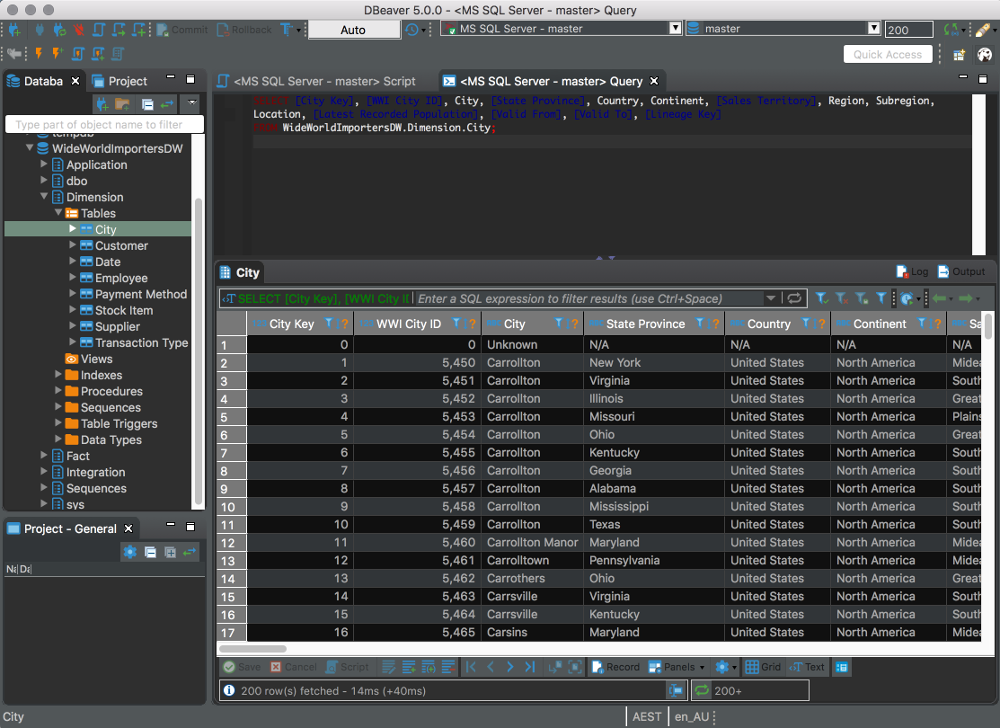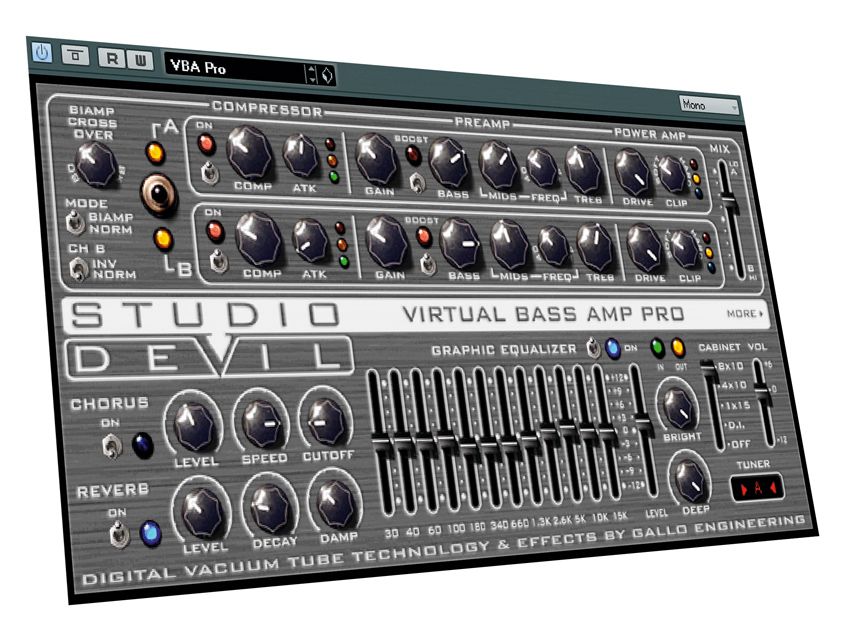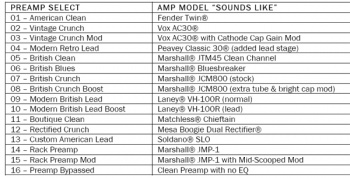Amp Modeler Pro offers an elegant interface, eschews clutter and is the only native amp sim to feature a boutique Matchless Chieftain emulation.
299 Insane Guitar Licks + 12 Jam Tracks! Guys, here I bring you another take on Studio Devil Guitar Amp Modeler Pro. Studio Devil Amp Modeler Pro demo at NAMM 2010 in Anaheim, CA.
The Amp Modeler Pro has 4 studio-quality modulation effects: Chorus, Flanger, Phaser, and Tremolo, all fully adjustable that can be positioned Pre/Post preamp to choose from that floor Pedal or Loop Effect sound. There's also an Echo/Delay Modeler with Normal/Stereo Ping-Pong Modes and continuously adjustable Style Knob. Studio Devil Amp Modeler Pro is a guitar amp modeling and audio effects plug-in for use with VST. Product Description for the Studio Devil AMP Modeler Pro. Gimp download mac os catalina download. Studio Devil Amp Modeler Pro is a guitar amp modeling and audio effects plug-in for use with VST, AudioUnits, and ProTools RTAS compatible hosts running on both Mac and Windows platforms.
by Per Lichtman, Sept. 2018
Studio Devil Amp Modeler Pro ($149 USD from StudioDevil.com) is guitar amp simulation that just plain does things differently. While it offers a wide variety of tones and models, perhaps the most unique one is the Boutique one, an emulation of the Matchless Chieftain. The original is a great amp and the emulation here offers a particular brand of rich, delicate tones you won’t find in other native plug-ins. Of course when the time comes to turn things up for high gain tones, Studio Devil Amp Modeler Pro has a lot to offer, too. In all there are fifteen amp models on offer and there’s the option to bypass the amp entirely and just use the cabs or FX. This review, based on version 1.5, helps lay out the ways in which Amp Modeler Pro’s workflow, strengths and weaknesses differ from other amp sims, so if you’re looking for a guitar amp plug-in, read on!

The Sound
The first time I met Marco Gallo (the founder and CEO of the Studio Devil) at NAMM, he told me that the key to amp modeling, was really nailing the emulation of the 12AX7A triode. Studio Devil put a lot of time and effort into really getting the sound of that ubiquitous tube and the attention to detail manifests itself in tones that are a little different from other amp sims, even if compared to them without cabinet emulation.

Just for the heck of it, I decided to try all the three clean model emulations without a cabinet impulse to see just how much difference there was between them. Even then, the rich, creamy character of the Boutique Clean clearly came through. Ever since I first loaded the model, it has been my favorite clean tone. And no matter how many other clean tones I try in lots of different amp sims, I’ve yet to find one that feels as rich as AMP Modeler Pro’s Boutique Clean, based off the Matchless Chieftain. There are all sorts of other well-done amp models in the package but this is definitely the star of the show in my book.
One thing I found when testing was that when I really needed to get some over-the-top crunch in my distortion, I sometimes felt like Studio Devil Amp Modeler Pro could be pushed a bit harder than its competitors. Apple affinity photo.
The Interface
AMP Modeler Pro is all about keeping things simple and easy. Excluding the preset management, there are only two drop-down menus and literally almost every control is always visible in the main screen (save for the four modulation effects that you click between near the center of the interface – and a tuner and serial number display you can see clicking the MORE button the right side). It’s great for getting work done quickly, and unlike products such as Amplitube 4 (where there are always many tabs to keep track of) or S-Gear (with a layout that’s always changing depending on the components of your sound) you’ll find the same controls in the same places no matter what amp you’ve got loaded and you only have to learn them once.

The controls are pretty clearly labeled, usually with an obvious effect on the sound so the learning curve is reasonably short. The top row is your main amp controls: amp model, input level, quality level, high-pass filtering, extra deep frequencies, extra high frequencies, gain, boost gain switch, tone controls, power amp type and power amp drive. Next comes the cab selection, the seven-band graphic EQ (which can be switched between pre and post AMP mode and has several additional controls), the final master output level and an optional Wah-Wah filter (which you can control using automation in your DAW). The bottom two rows are dedicated to FX (compressor, chorus, flanger, phaser, tremolo, echo, reverb and gate) with most FX offering a switch to move them between pre and post amp modes. Using the FX pre-amp means they are processed in mono, whereas using them in post-mode means they operate in stereo where appropriate. No specific inspirations are mentioned for their models, but they all have a nice solid sound and are very simple and easy to use.
A Quick Note about Documentation
Studio Devil provides a 37 page PDF manual and after the first nine pages (dedicated to installation and authorization) it gets really useful. There are sections on the philosophy of the product, how to best setup level, a list of the amps modeled and sections for what seemed like every single component and control – from the Deep and Bright Controls on into how to use MIDI learn. It’s well-written, well organized, a quick read and extremely helpful. Kudos!
Amp Models
There are 15 amps on offer, along with the bypass mode. The amp modeled for each type is clearly laid out in the manual, so I’ve adapted the table used for inclusion here. Smart label printer.
01 – American Clean (Fender Twin®)
02 – Vintage Crunch (Vox AC30®)
03 – Vintage Crunch Mod (Vox AC30® with Cathode Cap Gain Mod)
04 – Modern Retro Lead (Peavey Classic 30® (added lead stage))
05 – British Clean (Marshall® JTM45 Clean Channel)
06 – British Blues (Marshall® Bluesbreaker)
07 – British Crunch (Marshall® JCM800 (stock))
08 – British Crunch Boost (Marshall® JCM800 (extra tube & bright cap mod))
09 – Modern British Lead (Laney® VH-100R (normal)
10 – Modern British Lead Boost (Laney® VH-100R (lead)
11 – Boutique Clean (Matchless® Chieftain)
12 – Rectified Crunch (Mesa Boogie Dual Rectifier®)
13 – Custom American Lead (Soldano® SLO)
14 – Rack Preamp (Marshall® JMP-1)
15 – Rack Preamp Mod (Marshall® JMP-1 with Mid-Scooped Mod)
16 – Preamp Bypassed Clean Preamp with no EQ

You’ll find Fender, Vox, Marshall and Mesa Boogie are all represented (as they are in some competing plug-ins) alongside with the less commonly emulated Laney, Soldano and Matchless. It bears mentioning that this is the only Matchless native plug-in emulation I’ve found so far, which is kind of surprising given how great it sounds. The Soldano is probably my favorite for full leads and the Matchless is definitely my favorite for clean tones. I definitely suggest starting by trying those two out.
Cabs
There are 32 cabinet impulses from Studio Devil along with 58 impulses from Kazrog, a small handful taken from the larger ReCabinet offering. Studio Devil explicitly says they designed the interface with the custom cab impulses from third-party manufacturers in mind (such as Kazrog Recabinet or the RedWirez series) so there’s not an endless selection of cabs on offer. What’s here works well but you’ll have to rely on either the combination used in factory presets or a personal knowledge of what the names might be alluding to in order to get any idea of what cabinet goes with what model. I was honestly a bit lost the first time I loaded it and just sort of auditioned things until I found combinations that worked. On the other hand, once I loaded ReCabinet impulses or RedWirez ones, I was a happy camper, and it felt good to not be paying for a lot of cabinets I wasn’t going to use anyway. Also, it’s worth noting that I already sometimes use custom impulses in conjunction with other plug-in amps anyway, so it’s nice to not feel like you’re paying for a lot of cab impulses you might be bypassing.

Presets
The presets on offer work well, but don’t expect the sort of massive preset factory you’ll get with Amplitube or Guitar Rig. There are fifteen amp models and the core factory bank includes 32 presets. They aren’t organized by amp model or anything like that, and the preset and bank saving and loading is probably the weakest element of the product. I ended up mostly bypassing it and using the preset management built into my DAW (Cockos Reaper).
The Competition
Studio Devil Amp Modeler Pro
For clean tones that just sail, or for re-amping pre-existing miked lead guitar tracks, I currently prefer using Studio Devil Amp Modeler Pro’s Boutique Clean coupled with custom cabinet impulses I bought from RedWirez to every other amp emulation I have at my disposal. Whether I put it up against S-Gear, Guitar Rig 5 Pro, or Amplitube 4 Max, the Studio Devil Modeler Pro combo keeps being the one I find myself gravitating toward when I want the tone most exposed. The no-nonsense approach to the interface and focused selection here also means I never feel like I’m getting bogged down in comparing endless combination.
Regarding more driven tones, I felt that it really depended on the situation, and I sometimes found myself choosing Studio Devil Amp Modeler Pro, Amplitube 4 Max and S-Gear to all work together on the same track for each variation in the sound. If you strip away the FX and the cabs, it’s worth noting that I found that when using similar models in Amp Modeler Pro compared to Amplitube or Guitar Rig and trying to use similar settings, the sound feels a bit fuller and more up-front in Amp Modeler Pro. The process of comparing tones was quicker in Amplitube and Guitar Rig due to their superior preset management systems.
If I want to really add in the additional pedals and FX, or if I’ve got a relatively clean signal that I want to try coloring in a few different dramatic ways, I tend to head over to either Amplitube or S-Gear. In my testing, I would either reach for Studio Devil Amp Modeler Pro or one of those two, as II found all three of these to be preferable to Guitar Rig 5 Pro across the board. Of course, taste is a personal thing.
Amplitube 4 Max’s wider array of models, huge array of presets and matched cabinet mode option means that it’s a great choice for those that would rather load another preset or model than spend some time tweaking settings for an existing one. It’s also more than twice the price of Studio Devil Amp Modeler Pro. S-Gear is currently a little less expensive lands between Amplitube and Studio Devil Amp Modeler Pro in terms of workflow and complexity, with a lot of guitarists liking its tone. There are also other choices on the market, such as Overloud’s TH3, but I don’t have experience working with them to offer any comment.
If you’re using a guitar amp to process non-guitar signals, it’s worth noting that Studio Devil Amp Modeler Pro uses a mono input, unlike some competitors (including Guitar Rig, whose support of stereo input goes back further than most competitors).
Bass Amp Modeler
Is It Right For You?
Studio Devil Amp Modeler Pro is a great choice for many kinds of players. It’s great for those that want to spend their time tweaking a tone quickly instead of barreling through preset after preset. It’s great for those that want great Soldano SLO or Matchless Chieftain tones. It’s perfect for those that want a more up-front and fuller sound out of the core amp emulation (as opposed to relying more on the cab side). It’s got a nice smaller user interface that doesn’t dedicate a huge chunk of the screen to the amp GUI. It’s my favorite for a nice clear clean tone (either DI or re-amping a lead). In other words, it’s a great choice for a considerable diversity of users.
Studio Devil Amp Modeler Pro Full
On the other hand, if you find cabinet selection daunting and want to be able to load a matched set, the competitors have you covered better. If you want an even larger selection of models or a huge array of presets, Amplitube might be a better fit (although you’ll be missing out on the Matchless Chieftain). If you want a larger array of FX, you’ll be better served elsewhere. Studio Devil Amp Modeler Pro doesn’t try to do everything – it does a specific range of things very well. Even if you already own another amp plug-in, it can be a great additional color and it doesn’t take long to get up to speed, either.
Pro Modeler Kits
You may also be interested in:
